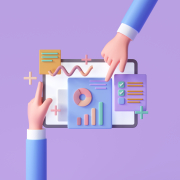Data-as-a-Service in banking: turn on the data tap and surf!
The processing and analysis of huge amounts of data is becoming more and more important for the world of finance every year. How not to drown in a flood of data but to leverage the banking data by-product?
This article discusses the following:
- why there is more and more data
- what needs to change for the potential locked in the data to be released
- what are the wins of the company using the DaaS model
- how the DaaS model supports real-time banking
The amount and variety of data available to banks and other financial services providers has continued to grow exponentially. IDC & Statista predict that 94 zettabytes of data will be created globally by the end of 2022, and 118 zettabytes in the next year.
Open banking allows non-bank entities to access and integrate banking data into their services through APIs, enhancing user experience without providing new banking products. This contrasts with the innovative services offered through Banking as a Service (BaaS).
Traditional banks, as any organization, are required to exchange more and more details about their transactions, investments, and portfolios. As a result of these commitments, the format for submitting data on international payments is changing. There are also growing needs related to reporting and striving for greater transparency in environmental, social, and governance (ESG) reporting.
Regardless of external reporting, business itself generates data in increasing amounts simply as a by-product of its operations. But to take full advantage of these ever-growing Big Data streams, providers of financial products and services need to find a way to use it efficiently. The idea is not only not to drown in a flood of data, but to be able to surf on that wave of growth. But how can this be done?
The data silo corsets the banking business
New datasets are structured and organized in a variety of ways and then made available as files or, more recently, using APIs. Commercial providers have been supplying up-to-date data for a long time, but although their products (ready-made databases) fit perfectly into the need for access to an increasing volume of data, they have one major disadvantage.
These databases are de facto silos, updated, e.g., once every 3 months. Although in the past it was enough for monthly or quarterly reporting, nowadays it is definitely not enough! What is more, in the traditional model, you cannot simply make use of a database. It must be uploaded into the system, which is maintained on corporate servers. Such a model increases costs as it curbs the freedom to combine different databases, from different vendors, and prevents the enormous volume of data simply from benefiting the company as it could. We also discussed it in the article “Data-driven work efficiency: knock over your IT banking architecture!“.
Third parties, such as fintech companies, utilize banking data through APIs to create new financial products and enhance customer experiences. These entities leverage the bank’s systems to offer innovative solutions, establishing a distinct relationship where the end user interacts primarily with these third-party services rather than directly with the banks.
How about more data-powered banking services?
Collecting, sharing, and analyzing data is a continuous process that needs data streams instead of silos. In recent years, companies in the financial services sector have been using more and more data sources, even in real time. The sources have been paired with increasingly sophisticated analytics, enabling employees from different areas self-service in data use so that they can make more informed decisions.
BaaS providers facilitate access to banking infrastructure for fintech companies and enhance service offerings for banks by sharing data, which helps generate new revenue streams and positions them as essential partners in the financial technology landscape.
To facilitate the use of various types of data and expand the pool of available databases, data providers are switching to the Data-as-a-Service (DaaS) model. In this model, the supplier is responsible for launching, maintaining, and controlling the data management infrastructure. The customer can access entire data sets via the user’s panel. They can also receive selected data formatted in various ways for integration with business applications.
DaaS in financial services: data converter needed ASAP
The future of data trading in banking looks interesting. Using the data in the Data-as-a-Service model enables faster creation of proprietary analyzes with any combination of data types, both local and global. Combined with qualitative metrics for different data sets and sources, this can lead to a continuous improvement in data processing.
In order for such a model of operation to be possible, banks must find an efficient and cost-effective way to connect other data sources (on a plug-and-play basis). Having a solution that can transfer data from an external source (other banks or financial institutions) to their ecosystem, banks will be able to take full advantage of the potential of Data-Driven Banking.
Such solutions – let’s call them data converters – operate based on business rules. They greatly simplify data management by making connection of a new data source a plug-and-play operation, rather than a lengthy process of data conversion from a new source to the corporate ecosystem each time, which must be meticulously designed. To make the Data-as-a-Service model fit to serve financial institutions, it is enough to properly prepare a single set of business rules for input data conversion. After integrating the source with the converter, the solution will properly sort the incoming data stream in real time. This is how our proprietary application, Payres, works.
Surf the ocean of data in banking as a service
As we stressed in the article “5 reasons why your bank should switch to real-time banking”, the effort to process data in real time is worth the effort. Why? Well, first of all, customers trust banks that give them instant access to information about their personal finances. Second, by having access to real-time data, the bank can show real empathy for the customer and react when faced with some difficulty. And thirdly, in a broader context, banks can leverage real-time to reduce own costs and increase innovation. If they don’t, other financial market players will overtake them.
In the data-driven banking model, there is an ocean of possibilities for complementary financial services. Need to discuss banking solutions that support real-time data analysis? Do not hesitate to contact us!

